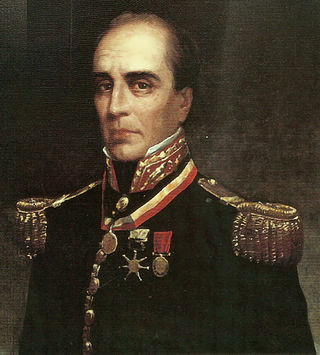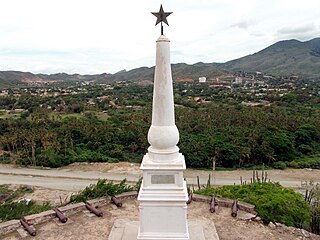Order of battle
| |||||
This is the order of battle for the Battle of Carabobo in 1821 in the Venezuelan War of Independence during the Spanish American wars of independence.

José Antonio Páez Herrera was a Venezuelan leader who fought against the Spanish Crown for Simón Bolívar during the Venezuelan War of Independence. He later led Venezuela's independence from Gran Colombia.

Valencia is the capital city of Carabobo State and the third-largest city in Venezuela.

The Battle of Boyacá (1819), was the decisive battle that ensured the success of Bolívar's campaign to liberate New Granada. The battle of Boyaca is considered the beginning of the independence of the north of South America, and is considered important because it led to the victories of the battle of Carabobo in Venezuela, Pichincha in Ecuador, and Junín and Ayacucho in Peru.

Rafael José Urdaneta y Farías was a Venezuelan General and hero of the Spanish American wars of independence. He served as President of Gran Colombia from 1830 until 1831. He was an ardent supporter of Simón Bolívar and one of his most trusted and loyal allies.

The Battle of Chacabuco, fought during the Chilean War of Independence, occurred on February 12, 1817. The Army of the Andes of the United Provinces of the Río de la Plata, led by Captain–General José de San Martín, defeated a Spanish force led by Rafael Maroto. It was a defeat for the Captaincy General of Chile, the royalist government established after the division of the Viceroyalty of Peru.

The Battle of Carabobo, on 24 June 1821, was fought between independence fighters, led by Venezuelan General Simón Bolívar, and the Royalist forces, led by Spanish Field Marshal Miguel de la Torre. Bolívar's decisive victory at Carabobo led to the independence of Venezuela and establishment of the Republic of Gran Colombia.

The Battle of Ayacucho was a decisive military encounter during the Peruvian War of Independence. This battle secured the independence of Peru and ensured independence for the rest of South America. In Peru it is considered the end of the Spanish American wars of independence in this country, although the campaign of Antonio José de Sucre continued through 1825 in Upper Peru and the siege of the fortresses Chiloé and Callao eventually ended in 1826.
Achaguas is a small town in Apure State in Venezuela, in the Achaguas Municipality. It is located 80 kilometres (50 mi) west of San Fernando de Apure, the capital city of the state.

Pedro Camejo, also known as Negro Primero, was a Venezuelan soldier that fought with the Royal Army and later with the Independence Army during the Venezuelan War of Independence, reaching the rank of lieutenant. The nickname Negro Primero was inspired by his bravery and skill in handling spears, and because he was always in the first line of attack on the battlefield. It is also attributed to his having been the only black officer in the army of Simón Bolívar.

Ambrosio de La Plaza y Obelmejia was a military figure involved in the Venezuelan War of Independence. Born in Caracas, he joined the army at the age of 19. He fought under Francisco de Miranda and later served under Simón Bolívar. Involved in operations against royalist forces entrenched in Bogotá in 1814, he later fled with Bolívar to Jamaica and Haiti.
Carabobo may refer to:

Jacinto Lara was a Venezuelan independence leader and hero of the Venezuelan War of Independence. His contribution included participating in Simón Bolívar's 1813 Admirable Campaign. He was briefly Prefect of the Intendency of the Magdalena River and the Isthmus in 1821. He later led a reserve division at the Battle of Ayacucho (1824), a decisive military encounter during the Peruvian War of Independence.

United Kingdom–Venezuela relations are the bilateral relations between the United Kingdom and Venezuela since 1821 when so-called "British Legions" of former British soldiers fought to defend the Second Republic of Venezuela against Spanish royalists in the Venezuelan War of Independence.

The Battle of Azcapotzalco,, was fought on August 19, 1821, in the town of Azcapotzalco, near Mexico City. It was to be one of the last military action of the Mexican War of Independence. The insurgents, commanded by the colonels Anastasio Bustamante and Luis Quintanar, fought the Spanish forces commanded by Manuel de la Concha.

The Battle of Matasiete was a battle in the Venezuelan War of Independence that took place on 31 July 1817 near the city of La Asunción on Isla Margarita in Venezuela. It was fought between pro-independence Republican revolutionaries led by Francisco Esteban Gómez and Spanish Royalist forces under the command of Pablo Morillo. The outcome was a Spanish defeat.
The First Battle of Carabobo (1814) was a battle in the Venezuelan War of Independence, in which the forces of the Second Republic, commanded by Simón Bolívar, defeated the Spaniard forces under Field marshal Juan Manuel de Cajigal y Martínez.

The Plaza Bolívar is a square in Valencia, Venezuela. It occupies a central site, and is used for public meetings. Its origin was in the colonial period, when the city was laid out on a grid plan.(see note) Some buildings in the vicinity, such as the Cathedral date from the colonial period.

The Presidential Honor Guard is the military brigade responsible for the immediate security of the president of Venezuela. The current head of the Presidential Honor Guard is Iván Hernández Dala.
Inés María Jiménez was an Ecuadorian revolutionary heroine who participated in several battles in the Ecuadorian War of Independence.

The Hussars of Junín, officially the Cavalry Regiment "Hussars of Junín" № 1 Liberator of Peru, is a traditional light cavalry regiment of the Peruvian Army. Originally the 4th Squadron of the Peruvian Guard Legion, the unit was renamed in 1824 to its current name after its performance in the Battle of Junín.